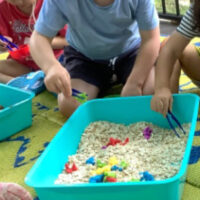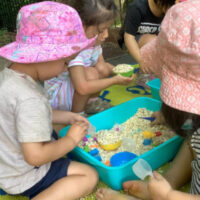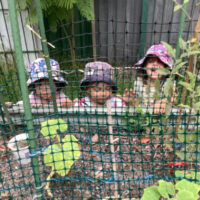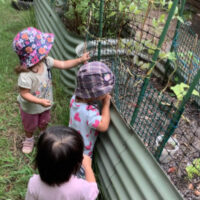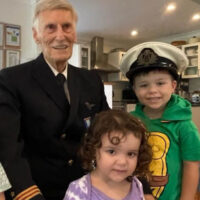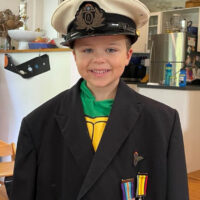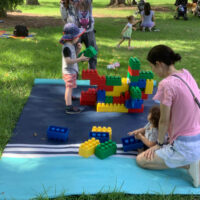Johnson House
Banksia Room
Story by Occupational Therapist Amanda
We used rolled oats and brown flaxseed meal for some sensory play in Johnson House Banksia room this week.
Initially we buried tiny colourful dinosaurs and then rescued them with tweezers, and some of the children chose to sort the dinosaurs into matching coloured bowls. As play continued, I added tiny scoops and some cups, and some of the children began using their hands to scoop, pour, and bury individual dinosaurs in their bowls/cups.
Fine motor skills, including in-hand manipulation of objects, bi-lateral coordination of the upper limbs, finger/hand strength, finger isolation and hand-eye coordination, are developed through using tweezers. Cognitive skills such as concentration, attention, learning to organise and concepts (colour, shape, size etc.) were developed through the matching and sorting aspects of the activity.
There are many benefits to encouraging children to use small tools and utensils. Tweezers are a particularly good example of a tool that provides opportunities for the refinement of hand-eye coordination and fine motor control. Tweezers allow for the subtle and indirect preparation for writing by gently encouraging the hand to curl into the ‘pincer grip’ which is used when writing. Working with tweezers is also an engaging exercise, which promotes attention to detail and sustained concentration.
Murray House
Jacaranda Room
Story by Educator Yi
Today a small group of children in Murray House Jacaranda room spontaneously explored the veggie garden, observing the cherry tomatoes and other plants such as sweet potato leaves and lemon grass. They were encouraged to feel the texture of the different types of leaves, and to smell the lemon grass as we picked a few of the leaves up from the soil.
We put the lemon grass underneath our noses and took deep breaths to smell it. We also smelled the leaves of the herbs and other plants, and discussed what we could smell.
We spoke about herbs and spoke about how sometimes our families use herbs just like ours to make their cooking taste nicer. We also spoke about how eating herbs, vegetables and fruits help our bodies grow strong!
The children love exploring the wonderful natural environments around them, and it is fantastic that they are taking time to develop knowledge and responsibility for the natural environments here in Murray House.
Family Day Care Sydney Wide
Story by Educator Support Officer Alix
During a home visit to Educator Kate’s Family Day Care in Lane Cove last week, Kate shared that one child, Charles, has a very keen interest in aeroplanes. In particular, he enjoys observing and identifying the different aeroplanes that fly over Kate’s service, on the flight path to and from the airport.
Kate said that the following Wednesday would be Charles’ 5th birthday and that, as a very special surprise, she had organised for her dear old friend, Pat, who was a flight director for Qantas, to visit her service in his full pilot’s uniform to share the best of his aviation knowledge with this budding young aviator.
Charles was very surprised and happy to meet Pat, who at only 96 years young, drew diagrams of aeroplanes on the whiteboard, detailing different plane characteristics. Charles was also lucky enough to try on Pat’s uniform. It can only be imagined how special and meaningful this day was for Charles.
This was a wonderful demonstration of how Kate embedded connections with community and intergenerational learning opportunities, which was special for all involved.
Community Playgroups
Story by Playgroup Coordinator Rebecca
One of our favourite activities at playgroup is the giant construction blocks. The giant blocks are not only fun, encouraging teamwork and helping to build social connections between children as they play, they are also safe for little ones who are exploring their world by putting things into their mouths.
Much like the regular-sized construction bricks that we all know, these giant blocks help and encourage children to communicate with others and to practice their language skills by sharing their ideas and listening to others. They are learning to problem solve and working out how to share with others.
Looking at the blocks and manipulating them helps to make connections within a child’s brain, which aids in the development of their understanding of mathematical concepts and spatial awareness. Children learn how to move the blocks within the play space, working out how to connect them and to create from their imaginations. Children also use their gross motor skills to move the blocks around them and to build with them.
In the photos, we can see a very young child watching an older child who has the skills and knowledge to create and build with the blocks. After a while, the younger child moved toward the blocks, using their gross motor abilities and learning about social connections as he joined the older child in play.
We often repeat activities at playgroup so that the children can observe, learn and practice on a regular basis.
